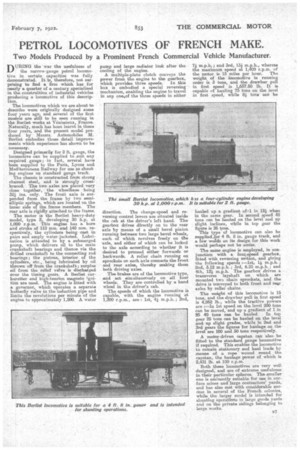PETROL LOCOMOTIVES OF FRENCH MAKE.
Page 9

If you've noticed an error in this article please click here to report it so we can fix it.
DUAING the war the usefulness of the narrow-gauge petrol locomotive in certain capacities was fully demonstrated. It, is therefore, not surprising to find a firm which has for nearly a quarter of a century specialized in the construbtion of industrial vehicles producing a locomotive of this description.
The locomotives which we are about to describe were originally designed some four years ago, and several of the first models are still to be seen running in the Berliet works at Veniesieux, France. Naturally, much has been learnt in those four years, and the present model produced by Messrs. Automobiles M. Berliet embodies those detail improvements which experience has shown to be necessary.
Designed primarily for 2 ft. gauge, the locomotive can be supplied to ,suat any required gauge; in fact, several have been supplied to the Paris, Lyons and Mediterranean Railway for use as shunt. lug engines on standard gauge track.
The chassis is constructed from strong channel steel, and is strongly cross braced. The two axles are placed very close together, the wheelbase being 321 ins. only. The front axle is suspended from the frame by two semielliptic springs, which are located on the inner side of the frame members. The rear axle is rigidly attached to the frame.
The motor is the Borliet heavy-duty model, type Z, developing 30 h.p. at 1,000 r.p.m. This engine has a bore and stroke of 110 mm. and 140 mm. respectively, the cylinders being cast an pairs and amply water-jacketed. Lubrication is attended to by a submerged pump, which delivers oil to the main crankshaft bearings and thence via the drilled crankshaft to the connecting rod bearings ; the pistons, interior of the cylinders, etc., being lubricated by oil thrown off from the crankshaft ; surplus oil from the relief valve is discharged Over the timing gears. A Bediet carburetter and high-tension magneto ;gnition are used. The engine is fitted with a governor, which operates a separate butterfly valve in the induction pipe and limits the revolutions per minute of the engine to approximately 1,200. A water pump and large radiator look after the cooling of the engine. A multiple-plate clutch conveys the power from the engine to the gearbox,
which provides three speeds. In this: box is embodied a special reversing mechanism, enabling the engine to travel in any onehof the three speeds in either
direction. The change-speed and re versing control levers are situated inside the cab at the driver's left hand. The gearbox drives directly on to the rear axle by means of a small bevel pinion running between two large bevel wheels, each of which revolves freely on the axle, and either of which can be locked to the axle acoording to whether it is desired to proceed either forwards or backwards. A roller chain running on sprockets on each axle connects the front and rear axles, thereby making thera both driving axles.
The brakes are of the locomotive typo, and act simultaneously on all four wheels. They are controlled by a hand wheel in the driver's cab.
The speeds of which the locomotive is capable, with the engine running at 1,200 r.p.m., are : 1st, 41 m.p.h.; 2nd, 71 m.p.h.; and 3rd, 134m.p.h., whereas the maximum speed at 1,400 r.p.m. of the motor is 15 miles per hour. The weight of the locomotive in running order is 3 tans, and the drawbar pull in first speed is 1,657.50 lb. It is capable of hauling 75 tons on the level in first speed, While 4 tons can be hauled up a gradient of•1 in 124when in the same gear. In second speed 48 tons can be hauled on the level and up slight inclines, while in top gear the figure is 26 kOMS. This type of locomotive can also be supplied...for 4 ft. 8 in. gauge track, and a few worels on its design for this work would perhaps not be amiss.
The same engine is employed, in eonjunction with a foursspeed gearbox, fitted with reversing motion, and giving the following speeds :-1st, 11 m.p.h. ; 2nd, 3.12 m.p.h. ; 3rd, 6.25 m.p.h.; and 4th, 121 m.p.h. The gearbox drives a transverse layshaft on which are mounted two chain sprockets, and the drive is conveyed to both front and mar axles by roller chains.
The weight of this locomotive is 15 tons, and the drawbar pull in first speed is 4,862 lb., while the tractive powers are :—In 1st speed on the level 200 tons can be moved, and up a gradient of 1 in 25 40 toes can be hauled. In top gear 25 tons can be hauled on the level and up slight grades, while in 2nd and 3rd gears the figures for haulage on the level are 100 and 50 tons respectively.
A moter-driven capstan can also be fitted to the standard gauge locomotive if required. This enables the locomotive to remain stationary and haul loads by means of a rope wound round the capstan, the haulage power of which is 2,431 lb. at 100 r.p.m.
Both these locomotives are very well designed, and are of extreme usefulness in their particular spheres. The smaller one is eminently suitable for use in surface mines and large contractors' yards, and has also met with considerable suedess in several of the French colonies, while the larger model is intended for shunting operations in large goods yards and on the private sidings belonging to large works.




























